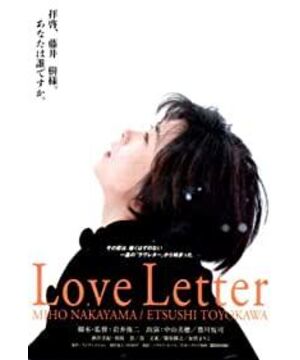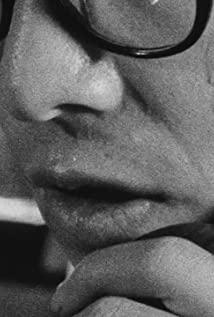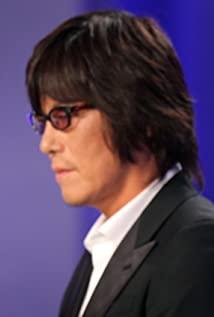1
Twenty years ago, there was a private interview with the director, said to be from Shunji Iwai’s Japanese fan site. How to refer to Haruki Murakami’s famous novel "Norwegian Forest" to explain how the characters in "Love Letter" are explained: the film The personalities and emotional fate of the male/female characters Fujiiki, Watanabe Hiroko, and Akiba are all born out of the main characters Kizuki, Naoko, Watanabe, Midoriko, and Reiko in "Norwegian Forest"; Shunji Iwai is writing the script At the time, I carefully analyzed the personalities of these characters and their life trajectories in the novel, segmented and combined these elements, and re-shaped similar characters for "Love Letter" based on the inner theme of "Norwegian Forest". Different story lines reflect the same emotional atmosphere. The authenticity of this interview has yet to be verified, but it points out a very crucial point: "Love Letter" more or less carries the desperate atmosphere of "Norwegian Forest".
It is hard to say that "Norwegian Forest" is a truly perfect love novel in an emotional sense. The characters in the book are essentially in a state of "absent-minded" when in love: the heroine Naoko has always been attached to the suicide Mu Yue; On the one hand, the protagonist Watanabe fell in love with the wandering Naoko, while on the other side seemed to flirt with the young and energetic Midori; when Naoko committed suicide, he again "confided" Naoko's roommate Reiko as emotional and physical. Object. No one in the book really eagerly and attentively responds to another person's emotional appeal. They are all in a free state of "the body is here, but the heart is elsewhere."
If "Love Letter" really drew inspiration from "Norwegian Forest", then it is reflected in the inheritance of the misplaced emotional relationship: Otoiki in the film has been secretly crushing in various obscure and weird ways in the junior high school era. Female Fujii, the latter was ignorant of this; after adulthood, the male Fujii still had a strong attachment to the female Fujii, so he chose Watanabe Hiroko, who looked similar to the latter as his fiancé, but never revealed his true thoughts; until he After the death of a mountain disaster, the Bozi who loved him so much found out his psychological track from the clues: It turned out that he was just a substitute for the female Fujii tree; but the "emotional injury chain" did not stop here because of the male Fujii. The passionate pursuit of tree friend Qiuye, she continued to immerse herself in the nostalgia of the dead like a Stockholm syndrome patient, letting Qiuye confess her without comment; perhaps more ingeniously than "Norwegian Forest", she was a female Fujii Ten years later, when Shu saw his portrait on the back of the library card inserted in "Reminiscence of the Years", he suddenly realized the love he had missed, and this was another regret that he could never achieve emotions: the portraitist O Fujii The tree is already in heaven.
2
The protagonists such as Fujiiki, Watanabe Hiroko, Akiba, and other protagonists’ “ignorance” of current emotions and a strong desire for unavailable love constitute the inner core of "Love Letter" (in order to achieve the same character status, Shunji Iwai Even specially arranged for Qiu Ye to have a female student who was in love with him but was always ignored by him. On the contrary, Qiu Ye was also pushed into the ranks of "love hyperopia patients"). "The Love Letter" and "Norwegian Forest" also achieved a certain emotional unity in this obsession with the state of "desire" and undesirable.
However, compared to the desperate tone of "Norwegian Forest", "Love Letter" hides the dark side of this complex story with a sensational, sad and inspirational appearance. Audiences who have watched "Love Letters" easily overlook the role of Otoiki. For most of the film, he was in a state of being recalled after his death. But if we put aside the throbbing subjective memories of the two affectionate women, only in the retrospect of the facts, we can also find the strange and unreasonable side of his behavior: First of all, he adopted a crush on his crush when he was young. An attitude of lofty arrogance and hostility indifferent, he used the method of writing the name of the other party on the library borrowing card but was not ready to clearly inform the relationship with the female Fujii; secondly, his attachment state evolved into a similar appearance as an adult Obsessed, so he pulled Bozi into the relationship and acted as a "substitute" for the object of "obscene", and with this, he strongly controlled Bozi spiritually, bringing endless psychological shadow and pain to the latter. We can even describe his relationship with the two heroines as "a vicious crush" and "the coldest deception."
Compared with Fujii, who has never treated love sincerely, Hiroko is always in a passive and ignorant state of hindsight. After entering the middle of the film, Shunji Iwai cleverly shifted his perspective from Hiroko's search for secrets to the female Fujii who sinks into the memories of junior high school life, deliberately creating a leisurely and sweet youthful atmosphere in his light narration. But at this time, as long as we get rid of the deceptively sensational atmosphere and change our thinking, we will realize that every memory letter sent by female Fujiiki to Hiroko has pierced the latter's heart like a dagger—— On the day Hiroko left Otaru, he met the former's true face by chance, and immediately understood the intention of the male Fujii: He and Hiroko were only to continue his nostalgia for the female Fujii.
It is here that we have really seen Shunji Iwai’s work and the level of director. He is not only a little fresh man who writes and shoots some sweet and greasy movies, but is also good at wrapping the dark psychological reality with a seemingly pure and beautiful appearance. The author of the subtext. Audiences who relax their mental vigilance will be moved by the series of emotional youth narratives in "Love Letters", but those who understand a little bit of rational empathy will realize what kind of emotional and psychological trauma Bozi will experience when reading letters, and use Bozi's "shell" What kind of cruel scum, the man Fujiiki who continues his lustful emotions and ignores her true thoughts.
We may not be able to say that this is the case of the male Fujiiki's subjective wishes. After all, he may have a lot of unspeakable concealment and neglected to reveal the truth to the two women in ten years. However, Iwai Shunji's interest obviously goes beyond the entanglement of personal moral standards and enters the narrative level with the perspective of God: At the end of the film, the snowy mountain where the fiance is killed is still shouting in love with Hiroko and lying in the hospital. The female Fujii tree muttering on the hospital bed actually repeated the same greeting to the same person (the male Fujii tree); not only was Hiroko, who was always passive, failed to get rid of the bondage bondage of the male Fujii tree, she even had a crush on the original crush. The unknowingly female Fujii Shu also suddenly woke up after seeing the portrait on the back of the library card and fell into a sense of self-movement with regret. This is not a farewell to the deceased, but has evolved into a passive internal communication between the two women on the emotional and spiritual level: they have finally fallen into a fantasy nostalgia for the same person over the course of ten years. In the middle, and their emotions are destined to be tragically impossible to implement, because it is already a dead person who exerts "grass snakes and gray lines for thousands of miles" emotional control on them. This is no longer a "planning" that a human individual can do, but a huge joke played by fate on the parties. From this point of view, at the end of the film, the scene of the moving female Fujii Ki holding the seventh volume of "Reminiscence of the Years" and weeping seems to have a hint of cold and ironic fate.
3
In the 2016 film "Rip Van Winkel's Bride" by Shunji Iwai, he told an unprecedented strange story: the heroine Nanami who has a passive life and is completely manipulated continues to follow the trend of life , And in turn grateful for the amazing adventures brought to her by those who manipulated her destiny. Shunji Iwai presents a meaningful dualistic perspective in the film: the bewilderment, confusion, and even ridiculousness that the onlooker feels about the behavior of the person concerned is opposed to the principle of life that the person cannot abandon and must stick to the end.
We can regard Nanami in "Rip Van Winkel's Bride" as a fully extended development of the personality of Hiroko/Fujiiki in "The Love Letter". In fact, in "The Love Letter" Shunji Iwai has a strong consciousness to provide the audience with such a dual perspective: in the snowy night, the grandfather of female Fujiiki insisted on carrying her to the hospital after the pneumonia, completely disregarding her for ten years. This is how her former father died in the snowy night; this branch plot that seems to be completely disconnected from the main story reveals such a weird tenacious spirit-a failed death cannot change a person's inner emotional value. The method, stupidity and stubbornness in the eyes of outsiders is precisely the value that the parties believe. This is the reason why the awakened woman Fujiiki and the crying Bozi in the snow truly merge into one in spirit. Even if they are manipulated by their love partner and destiny, they cannot change their obsession with personal emotional value. . "Love Letter" and "Rip Van Winkel's Bride", as well as Iwai Shunji's other films such as "Swallowtail Butterfly", "April Story", "Everything About Lily Zhou", "Flower and Alice" are essentially Repeat the same theme again and again. In these films, Iwai Shunji's narrative angle constantly oscillates between the two. On the one hand, the black hole of fate manipulates and mocks the characters in all manners, and on the other hand, the characters are driven by their instincts to be blindly hardcore and completely reckless. insist.
In the "Last Letter" of 2020, along with the heroine Misaki Tono's infinitely imaginative speech about the future in high school, what we see is the dilapidated school building, decayed tables and chairs and empty space in the middle school 20 years later. Picture of a deserted corridor. At this moment, the tragic mockery of the heroine's fate from the director's perspective was unprecedentedly strong. In the interview mentioned at the beginning, Iwai Shunji once mentioned that he wanted to leave "Love Letter" with a bright ending that is different from "Norwegian Forest", so Hiroko was still full of hope while crying in the snow. Not just like the Naoko in "Norway" who died of suicide. But in the "Last Letter", he made Tono Misaki, who can also serve as a clone of Bozi, die of suicide caused by illness as soon as he came up, allowing everyone around her to appreciate her life of failure and frustration. She is obsessed with being undetected and understood. This battle between destiny and persistence has gradually hoped to dissipate and become a kind of nostalgic grief in "The Last Letter". I wonder if this represents Iwai Shunji's latest understanding of the constant theme of his works.
4
There is another detail in "Love Letter" that also reflects the magical nature of Iwai Shunji as a creator.
The film is full of a lot of details of writing and reading letters, and it seems that it is named "Love Letter" for granted. But when we think carefully about all the correspondence in the film (between Nv Fujii/Akiba and Hiroko), we will find that they are all explorations and memories of the past, and none of them are confession between real lovers. Until the secret of the library card was revealed, and the portrait of the female Fujii tree appeared in the picture, we realized that this was the only true love letter, and it was sealed on the last page of "Reminiscence of the Water Years" for ten years. No one has read/understood for a long time.
In "Letter to Milena", Kafka described the love letter to his lover as follows: after it was put in an envelope and sent out, but before the lover received it and opened it, the content of the letter was because no one knew it during the delivery process. , It was sealed up more like a spell cast by the devil. The "love letter" in "Love Letter" happens to be in the "devil spell" described by Kafka-because it is sealed in an unknowable state, all the characters are involved in a scene Amidst the mystery of emotions. At the end of the film, it was discovered and understood by the female Fujii, but it did not bring about the unblocking of the spell; on the contrary, the "devil's spell" spread out and dragged the female Fujii into the emotional dislocation. In the whirlpool. From this point of view, "Love Letter" is more like a "love letter cursed by the devil". It was carefully designed by Shunji Iwai, a fateful confession with both emotional touch and cold sarcasm towards personal obsessions.
View more about Love Letter reviews











